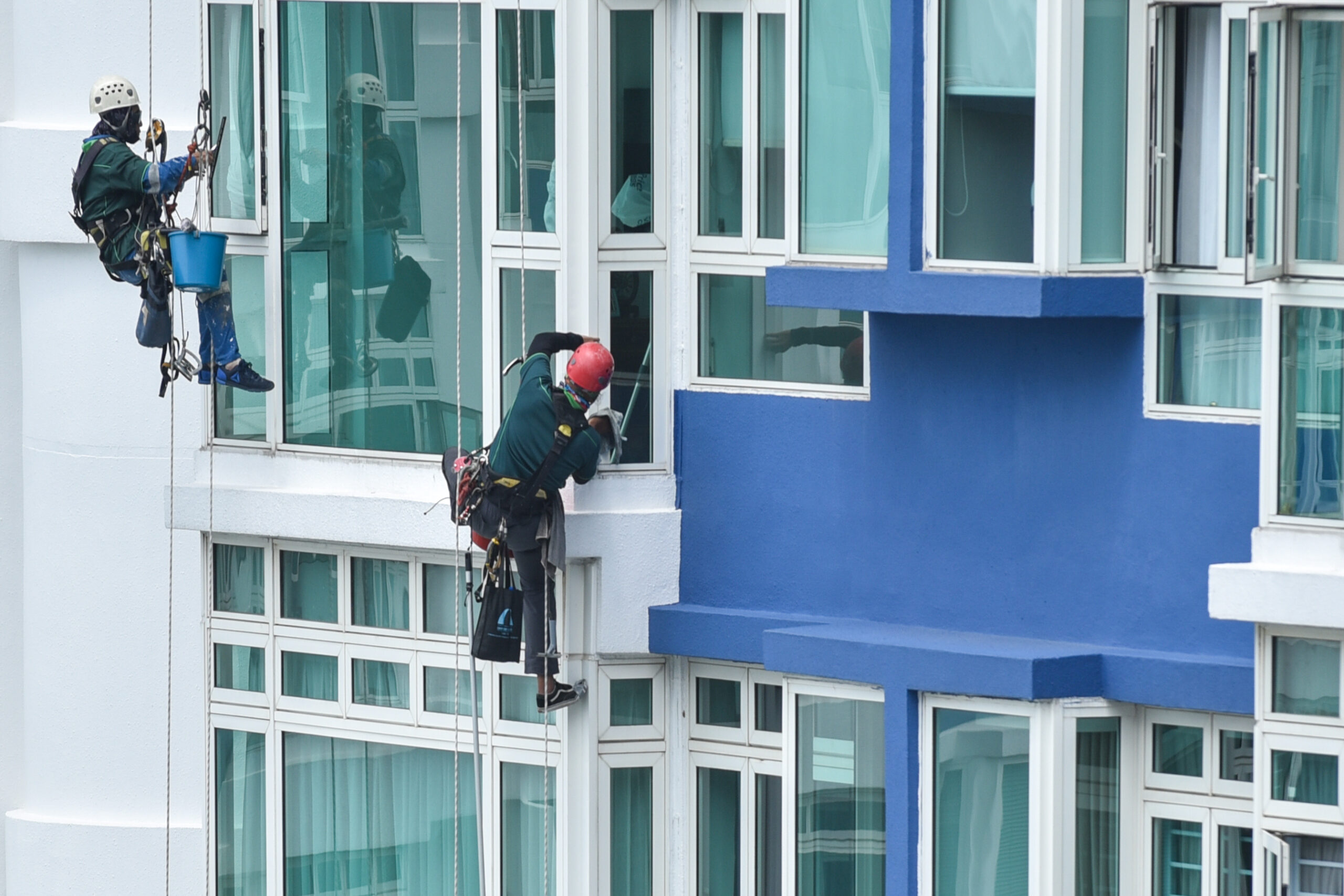Cleaning facade surfaces represents one of the most dangerous yet essential forms of labour in modern urban environments, yet the workers who risk their lives to maintain our gleaming city exteriors remain largely invisible. Every morning, millions pass beneath towering glass structures without considering the human cost required to keep these surfaces pristine. Behind every spotless building exterior lies a complex web of economic pressures and systematic undervaluation of human life.
The Economics of Height and Risk
The external building cleaning industry operates on a troubling principle: the higher the risk, the lower the pay. Workers who suspend themselves hundreds of metres above ground are among the lowest paid in construction, despite facing mortality rates that rival celebrated professions.
In Singapore, the Building and Construction Authority notes that “building owners are responsible for maintaining their facades and exterior features in a safe condition,” yet this responsibility rarely translates into adequate compensation for those performing the work.
The facade maintenance industry encompasses several high-risk categories:
- Rope access cleaning requires extensive safety certifications and equipment
-
High-pressure washing involving chemical exposure and fall hazards
-
Glass surface treatment demanding precision whilst working at dangerous heights
-
Concrete restoration exposing workers to dust and structural instability
-
Emergency cleaning services are often performed under time pressure and adverse conditions
The Regulatory Theatre of Safety
Singapore’s approach to facade maintenance safety creates what we might call “regulatory theatre” where extensive paperwork and training requirements give the appearance of worker protection whilst core economic relationships remain unchanged. Workers must undergo “training courses and certifications to perform rope access works” with “3 levels of skill tiers awarded after assessments from an association such as IRATA International,” yet these qualifications rarely result in wages commensurate with the skills and risks involved.
The Subcontracting Shell Game
The structure of the building exterior cleaning industry exemplifies how modern capitalism obscures responsibility through layers of subcontracting. Property management companies hire cleaning contractors, who employ facade maintenance firms, who engage workers through arrangements that often circumvent employment protections. This allows building owners to benefit from immaculate exteriors whilst maintaining plausible deniability about working conditions.
The rope access cleaning sector particularly demonstrates this responsibility diffusion. Companies must be “IRATA-accredited” and “have the presence of a safety supervisor who has undergone rigorous IRATA training,” yet these requirements focus on technical compliance rather than addressing the fundamental economic pressures that drive workers to accept dangerous conditions for inadequate pay.
Bodies in the Balance
The human cost of facade cleaning extends far beyond workplace accidents. The physical demands of working at height, exposure to cleaning chemicals, and constant psychological stress create cumulative health impacts that rarely appear in official statistics. Workers experience accelerated ageing, chronic pain, and elevated rates of anxiety and depression, yet these costs remain invisible to the broader economy.
The workforce consists predominantly of migrant workers, older men with limited alternatives, and individuals from economically marginalised communities. This reflects systematic sorting mechanisms that channel the most vulnerable workers into the most dangerous jobs.
The Technology Paradox
Advanced cleaning technologies have theoretically made facade maintenance safer, yet economic logic ensures improvements primarily benefit employers rather than workers. Better equipment allows faster job completion, but productivity gains translate into cost savings for contractors rather than improved wages.
Modern exterior cleaning operations utilise:
- Specialised chemical cleaning agents that reduce labour time but increase health risks
-
Advanced rope access systems that improve efficiency whilst maintaining dangerous working conditions
-
Automated cleaning platforms that threaten to displace human workers entirely
-
Digital monitoring systems that track worker productivity rather than wellbeing
-
Pressure washing equipment that speeds cleaning but increases physical demands
The Globalisation of Risk
Singapore’s position as a global financial centre creates particular pressures in building maintenance. International investors demand pristine exteriors to maintain property values, whilst global competition drives down labour costs. The result is a system where multinational capital benefits from immaculate facades whilst local workers bear the costs.
The emphasis on maintaining Singapore’s reputation as a clean city creates additional pressure for frequent exterior building cleaning, yet this civic pride rarely extends to ensuring dignified working conditions for those who make the gleaming cityscape possible.
The Inspection Regime
Singapore’s requirement that building owners “appoint a Competent Person to inspect the building facades upon receiving the PFI Notice, and carry out repair works as recommended by the CP” creates regular demand for dangerous exterior maintenance work. This regulatory structure ensures consistent employment for facade cleaning workers whilst institutionalising their risk exposure.
The inspection process reveals the broader pattern of how safety regulations can inadvertently perpetuate dangerous working conditions by creating legal requirements for high-risk work without addressing the economic relationships that make such work poorly compensated.
Environmental Contradictions
The push toward environmentally sustainable building maintenance practices creates additional complexities for exterior cleaning workers. Eco-friendly cleaning products may reduce environmental impact, but often require longer application times and more intensive labour, increasing worker exposure to heights and adverse weather conditions.
The irony is stark: whilst society celebrates green building maintenance practices, the workers implementing these supposedly progressive approaches continue to face systemic economic marginalisation and physical danger.
The Price of Pristine Appearances
The gleaming facades of modern cities represent more than architectural achievement; they embody a particular form of urban inequality where aesthetic perfection depends upon hidden human suffering. Every spotless glass surface and pristine concrete wall requires workers to risk their lives for wages that barely sustain basic living standards.
Until we acknowledge that truly sustainable cities must include sustainable livelihoods for all workers, the essential labour of cleaning facade surfaces will continue to represent one of the starkest contradictions of modern urban life: beauty built upon exploitation, cleanliness maintained through the systematic devaluation of human dignity.
